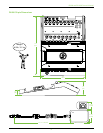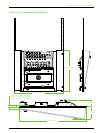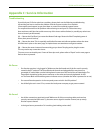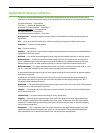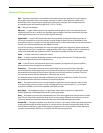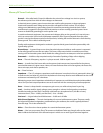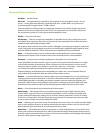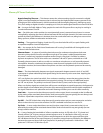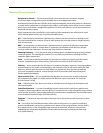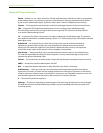
DL806 and DL1608 Owner’s Manual
43
Glossary Of Terms Continued...
Reverberation, Reverb
—
The sound remaining in a room after the source of sound is stopped.
It’s what you hear in a large tiled room immediately after you’ve clapped your hands.
Reverberation and echo are terms that are often used interchangeably, but in audio parlance, a distinction
is usually made: reverberation is considered to be a diuse, continuously smooth decay of sound, whereas
echo is one or more distinct, recognizable repetitions of a word, note, phrase or sound which decreases in
amplitude with every repeat.
Highly reverberant rooms are called live; rooms with very little reverberation are called dead. A sound
source without added reverb is dry; one with reverb added is wet.
RFI
—
Radio Frequency Interference. High frequency radiation that often results from sparking circuits.
This may be manifested in a number of ways in audio systems, but is usually evident as a high-frequency
buzz or harsh sound.
RMS
—
An acronym for root mean square, a conventional way to measure the eective average value
of an audio signal or other AC voltage. Most AC voltmeters are calibrated to read RMS volts, though
on many meters that calibration is accurate only if the waveform is sinusoidal.
Sampling Frequency
—
This is the rate at which an analog signal is sampled during the analog-to-digital
conversion process. The sampling rate used for CDs is 44.1 kHz, but professional recordings are often
sampled at higher sample rates.
Send
—
A term used to describe the output of a secondary mix of the input signals, typically used for
monitors, headphone amp or eects devices. These are the aux sends on the DL Series mixers.
Shelving
—
A term used to describe the shape of an equalizer’s frequency response. A shelving equalizer’s
response begins to rise (or fall) at some frequency and continues to rise (or fall) until it reaches the shelf
frequency, at which point the response curve attens out and remains at to the limits of audibility.
If you were to graph the response, it would look like a shelf. Or more like a shelf than a hiking boot.
See also peaking and dipping.
Signal-to-Noise (S/N)
—
This is a specication that describes how much noise an audio component
has compared to the signal. It is usually expressed in dB below a given output level. The S/N of the
DL Series mixers is 92 dB.
Solo
—
Italian for alone. Solo allows you to listen to individual channels singly or in combination with
other soloed signals.
Sound Reinforcement
—
A system of amplifying acoustic and electronic sounds from a performance
or speech so that a large audience can hear clearly. Or, in popular music, so that a (hopefully) large audience
can be excited, stunned, or even partially deafened by the tremendous amplication. Sound reinforcement
means essentially the same thing as PA [Public Address].
Spaghetti
—
That mess of wires and cables in the back of your rack and/or console. You really can tame
this beast.
SR
—
An acronym for Sound Reinforcement, which refers to the process (or a system for) amplifying
acoustic and electronic sounds from a performance or speech so that a large audience can hear clearly.
Or, in popular music, so that a (hopefully) large audience can be excited, stunned, or even partially
deafened by the tremendous amplication. Sound reinforcement means essentially the same thing
as PA [Public Address].



